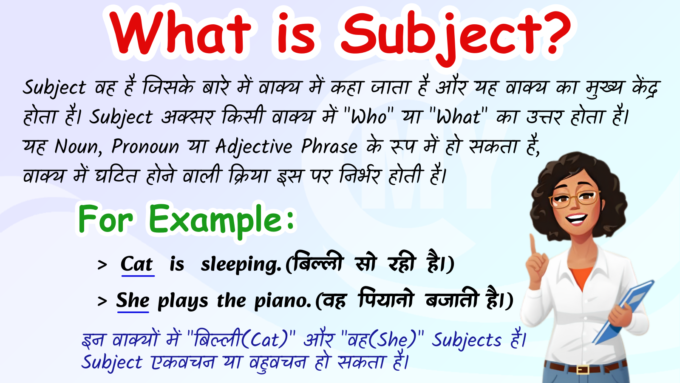Meaning and Definition of Subject
In English grammar, the subject is a fundamental component of a sentence. It may be the noun, pronoun, or adjective phrase that typically performs the action or is the focus of the sentence. The subject is what or whom the sentence is about. It provides information about the main entity or topic being discussed.
Subject वाक्य (Sentence) का वह भाग होता है जिसके विषय में हम कुछ कहते हैं; जैसे-
For example:
- Ravi bought a book. (रवि ने एक पुस्तक खरीदी।)
- John is reading a book.
उपर्युक्त वाक्यों में, “John” और “Ravi” Subjects हैं, क्योंकि वे खरीदने और पढ़ने की क्रिया कर रहे हैं। Subject को छोड़कर वाक्य का शेष भाग Predicate होता है।
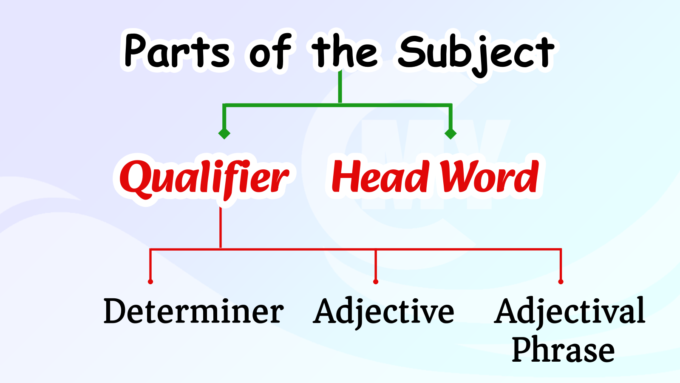
Read Also: Noun in English Grammar
QUALIFIER & DETERMINER
Qualifier (क्वालिफायर) का अर्थ है- विशेषता प्रकट करने वाले शब्द। जबकि Determiner (डिटरमिनर) का अर्थ है- निश्चित करने वाले शब्द।
Determiner के प्रयोग में निम्नलिखित शब्दों का प्रयोग होता है- a, an, the, some, any, much, several, few, little, each, every, all, both, either, neither, no, half, my, our, your, his, her, its, their, this, that, these, those, two, second (and other numbers).
अर्थात Determiners में निम्नलिखित सम्मिलित होते हैं-
- Articles; जैसे- A, an, the.
- Demonstrative Adjectives (संकेतवाचक विशेषण); जैसे- This, that, these, those.
- Possessive Adjectives (सम्बन्धवाचक विशेषण); जैसे- My, our, your, his, her, its, their.
- Adjectives of Quantity (परिमाणवाचक विशेषण); जैसे- Some, any, much, many, all, both, few, little, each, every, either, neither.
- Adjectives of Number (संख्यावाचक विशेषण); जैसे- One, two, first, second आदि ।
Determiners के विषय में P.C. Wren तथा H. Martin ने लिखा है-
“A determiner is a word that comes before a noun and limits its meaning. This term is used frequently in modern grammar.”
Learn in Detail: Adjective in English Grammar
Determiner तथा Qualifier का प्रयोग
इन दोनों प्रकार के शब्दों के प्रयोग के लिए निम्नलिखित उदाहरणों को ध्यानपूर्वक पढ़िए-
- A boy came.
- A fat boy came.
प्रथम वाक्य में A- Qualifier है, boy- Head word (Main word) है और came- Verb है। जबकि दूसरे वाक्य में A- Determiner है, fat- Qualifier है, boy- Head word है और came- Verb है।
(i) Head word से पहले Adjective आता है। Adjective से पहले Determiner आता है। अर्थात Determiner का प्रयोग उसी समय होगा जब उसके बाद में Adjective हो ।
(ii) जब Head word (Main word) से पहले कोई Adjective न हो तो Determiner का प्रयोग न होकर Qualifier का प्रयोग होता है।
Learn in Detail: Determiners in English Grammar
ADJECTIVE PHRASE
Adjective phrase की स्थिति के लिए निम्न उदाहरण को पढ़िए-
- Some pretty flowers in the pot are yellow.
इस उदाहरण में Some- Determiner है, pretty- Qualifier है, flowers- Head word (Main word) है, in the pot– Adjective phrase है तथा are yellow— Predicate है जिसमें are- Verb है और yellow- Complement (पूरक) है।
Determiner, Qualifier और Adjective Phrase की स्थिति इस प्रकार स्पष्ट होती है-
वाक्य में सर्वप्रथम Determiner, उसके बाद Qualifier, तथा Head word और उसके पश्चात Adjective Phrase (विशेषण वाक्यांश) आता है।
PHRASE
Phrase वह शब्द समूह है जिसका भाव तो हो, किन्तु पूर्ण भाव न हो।
- “Phrase is a group of words which makes sense but not complete sense.”- P.C. Wren
- “A combination of words, used to represent a part of speech, and not containing a Finite verb, is called a Phrase.”- F.T. Rowe तथा W.T. Webb
Phrases तीन प्रकार की होतीं हैं- (i) Noun Phrase, (ii) Adjective Phrase, और (iii) Adverb Phrase.
- Noun Phrase (संज्ञा वाक्यांश) Noun का कार्य करती है।
- Adjective Phrase (विशेषण उपवाक्य) Adjective का कार्य करती है।
- Adverb Phrase (क्रिया-विशेषण उपवाक्य) Adverb का कार्य करती है।
For example:
- I heard of his success. (इस वाक्य में of his success- Noun Phrase है।)
- He has a chain of gold. (इस वाक्य में a chain of gold- Adjective Phrase है।)
- They rested at sunset. (इस वाक्य में at sunset- Adverb Phrase है।)
Learn in Detail: Phrase in English Grammar
POSITION OF SUBJECT
The subject holds a significant position in a sentence, usually appearing at the beginning to convey the main focus or performer of the action. In English, the subject usually precedes the verb in declarative statements and questions.
For example:
- John plays soccer.
- Did you eat lunch?
In some cases, the subject can be placed after the verb, particularly in sentences that begin with an adverbial phrase or dependent clause.
For example:
- In the park, children were playing.
- After finishing his work, he went home.
This happens when the sentence starts with a phrase or a clause that gives extra information. It’s done to put more emphasis on that part or to make the sentence sound special in a certain way.
In imperative sentences, we sometimes don’t need to say the subject directly. We can leave it out because it’s understood who we’re talking to or giving the command to.
For example:
- Sit down.
- Open the door.
In these sentences, the subject is not directly mentioned, but we can understand that it refers to the person or people who are being spoken to or addressed.
Learn in Detail: Clause in English Grammar
Use of Determiner, Qualifier and Adjective Phrase in Subject
जैसा कि बताया जा चुका है कि वाक्य में सर्वप्रथम Determiner, उसके बाद Qualifier, तथा Head word और उसके पश्चात Adjective Phrase (विशेषण वाक्यांश) आता है। इसे और अधिक विस्तार में आगे समझाया गया है-
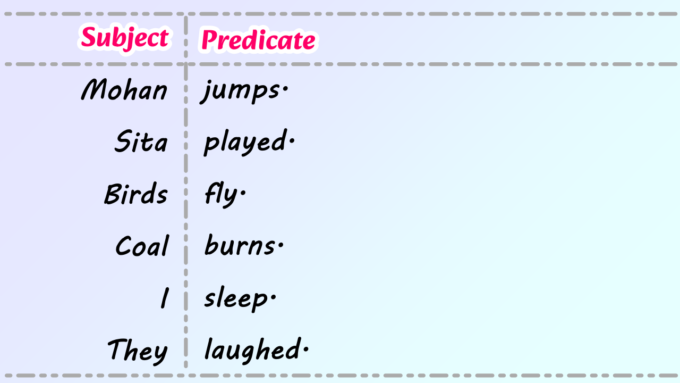
उपर्युक्त तालिका में प्रत्येक वाक्य के दो भाग हैं- (i) Subject और (ii) Predicate. प्रत्येक वाक्य का Subject या तो Noun है या Pronoun और वाक्य का Predicate क्रिया (Verb) है।
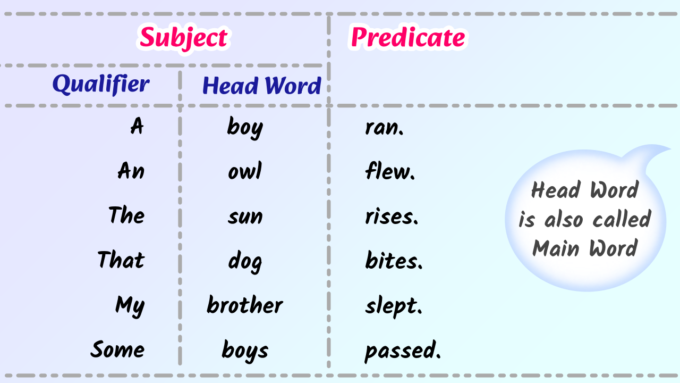
उपर्युक्त तालिका में भी प्रत्येक वाक्य के दो भाग हैं- (i) Subject और (ii) Predicate. और प्रत्येक वाक्य के Subject के दो भाग हैं- (i) Head word (Main word), और (ii) Qualifier. प्रत्येक वाक्य में Head word (Main word) “Noun” है ।
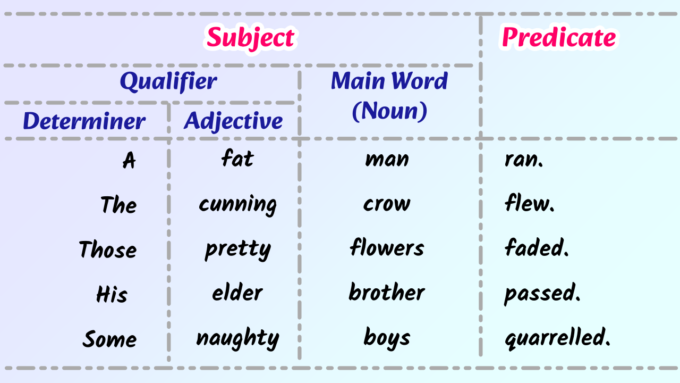
तालिका में प्रत्येक वाक्य का Subject दो भागों से मिलकर बना है–(i) Head word (Main word), तथा (ii) Qualifier. प्रत्येक वाक्य का Head word (Main word) “Noun” है । Head words के Qualifiers, Determiner तथा Adjective भी हैं।
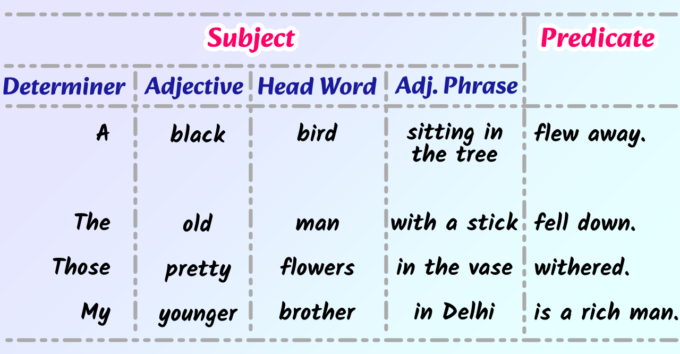
इस तालिका के प्रत्येक वाक्य का Subject (उद्देश्य) Head word, Determiner, Adjective तथा Adjective phrase से मिलकर बना है। प्रत्येक वाक्य का Head word (Main word) संज्ञा (Noun) है।
- Adjective phrase को Adjectival Phrase भी कहा जाता है।
- Determiner तभी आता है जब Head word (Noun) से पहले Adjective हो।
- Adjective Phrase के तुरन्त बाद Predicate आता है।
- Head word का प्रयोग Adjective और Adjective Phrase के बीच होता है।
Use of Gerund and Infinitive as a Subject
किसी वाक्य का Head word (Main word), Noun, Pronoun, Gerund तथा Infinitive हो सकता है।
Gerund का Subject के रूप में प्रयोग:
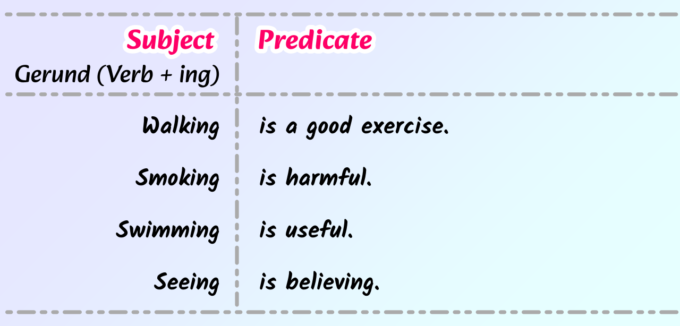
उपर्युक्त तालिका में प्रत्येक वाक्य का Subject केवल Head Word है, और यह क्रिया (Verb) का -ing रूप (form) है।
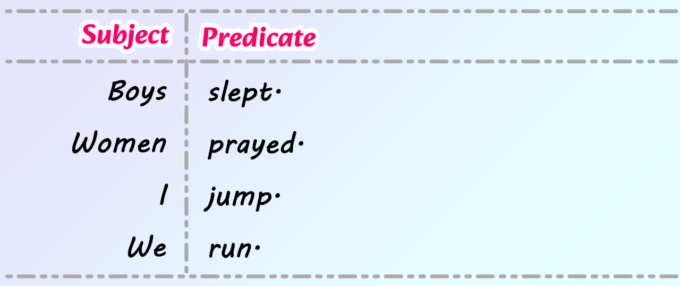
उपर्युक्त तालिका में पहले दो वाक्यों के Subject में Nouns का प्रयोग हुआ है जबकि बाद के दो उदाहरणों में Pronouns का प्रयोग हुआ है। प्रत्येक वाक्य में Predicate में केवल एक शब्द है जो Intransitive Verb है।
Infinitive का Subject के रूप में प्रयोग:
जिस प्रकार Gerund का प्रयोग Subject की तरह होता है, उसी प्रकार Infinitive (To + Verb की First form) का प्रयोग भी होता है।

उपर्युक्त तालिका में प्रत्येक वाक्य का Subject केवल Head word है और यह Head word (Main word)- Infinitive (To + Verb की First form) है।
नोट– Verb की First form (मूल रूप) से पहले To बढ़ाने से Infinitive बनता है। यह Noun, Adjective तथा Adverb का कार्य करता है।
Infinitives दो प्रकार के होते हैं-
- Simple (Noun) Infinitive,
- Gerundial Infinitive.
केवल Simple Infinitive ही Noun का कार्य करता है। उदाहरण के लिए:-
- To err is human. (गलती मनुष्य से ही होती है।)
- To forgive is divine. (क्षमा करना ईश्वरीय गुण है।)
- To smoke is harmful. (धूम्रपान हानिकारक है।)
कुछ वाक्यों में प्रयुक्त Gerund को Infinitive तथा Infinitive को Gerund में बदला जा सकता है; जैसे-
- To smoke is harmful. (Infinitive) = Smoking is harmful. (Gerund)
Use of “IT” and “THERE” as a Subject
The pronouns “it” and “there” have various uses in English. “It” is often used as a subject or object to refer to things, animals, or ideas. “There” is commonly used to indicate a location or existence.
It और There का प्रयोग भी Subject के रूप में होता है।
For Example:

उपर्युक्त सूची के प्रथम दो वाक्यों में It तथा अन्य दो वाक्यों में There का प्रयोग Subject के रूप में हुआ है। It का प्रयोग निर्जीव के रूप में और There का प्रयोग Introductory Adverb की तरह हुआ है।
ऐसे वाक्यों में There का अर्थ ‘वहाँ’ नहीं लगता है; जैसे-
- There are forty boys in the class. (कक्षा में चालीस लड़के हैं।)
- There is no problem. (कोई समस्या नहीं है।)
Test yourself
Pick out the subject and the predicate in the following sentences:
- Dogs bark.
- The sun sets in the west.
- Silver is white.
- Gold is yellow.
- Girls slept.
- Swimming is my hobby..
- Smoking is injurious.
- It was hot.
- It is painful.
- There is nobody here.
- Your agent in Gorakhpur is cunning.
- My younger brother lives in Delhi.
- Your elder sister lives in Sitapur.
- The girls in my class are wise.
- The red bulb in my room fused yesterday.
- To toil is the lot of mankind.
- To give is better than to receive.
- There lived a blind man in the village.
- There are five girls in the room.
- The yellow flowers in my garden are very beautiful.
Find out the subject and the predicate parts in the following sentences:
- The sun is very hot.
- That dog bites.
- Some boys failed.
- Your elder sister is in the garden.
- An honest man is respected.
- An old tiger was sitting under a tree.
- The yellow mangoes in the basket are sweet.
- The lame man with a stick slipped.
- Few men succeed.
- That girl sang well.
- My brother plays cricket.
- My youngest brother is in Delhi.
- A clever boy was weeping near a well.
- His elder brother shouted.
- My younger brother in Kanpur is a famous doctor.
- A few good girls in my class submitted their exercise books.
FAQs on Subject in Grammar
What is the subject in grammar?
In grammar, the subject is a noun, pronoun, or noun phrase that typically performs the action or is the main focus of a sentence. It provides information about the entity or topic being discussed.
How do you identify the subject in a sentence?
To identify the subject in a sentence, you can ask the question “who” or “what” before the verb. The answer to that question is likely to be the subject. Additionally, the subject is often the noun or pronoun that agrees with the verb in terms of number and person.
Can the subject appear anywhere in a sentence?
In most cases, the subject appears at the beginning of a sentence before the verb. However, there can be variations, such as when starting with an adverbial phrase or dependent clause. The subject’s position depends on the sentence structure and the emphasis intended.
Can a sentence have multiple subjects?
Yes, a sentence can have multiple subjects. This is known as a compound subject. It consists of two or more nouns, pronouns, or noun phrases that share the same verb and function as the subject of the sentence.
What is the difference between a subject and an object?
The subject is the noun or pronoun that performs the action or is the main focus of the sentence. On the other hand, the object is the noun or pronoun that receives the action of the verb. In simple terms, the subject acts, while the object is acted upon.
